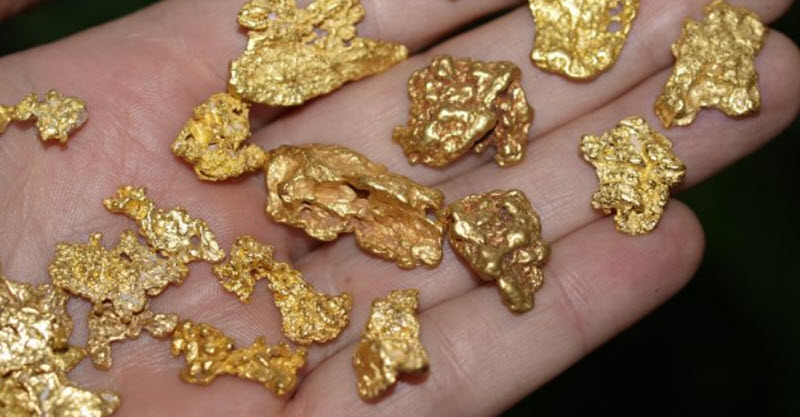Contents
A gold nugget is a naturally occuring piece of native gold that has been weathered out of an original lode. Many of the large gold nuggets that have been found around the world throughout history is no longer in existence as nuggets, since they have been melted down and turned into new golden objects. The huge Welcome Stranger nugget listed below was for instance broken into pieces and then melted down to make ingots.
Since gold nuggets have been weathered out of an original lode, they often display signs of abrasive polishing. Many of them contain non-gold materials alongside the gold, such as quartz, silver and copper. Some of them contain electrum, which is a gold-silver alloy.
Most of the studied gold nuggets have had a purity of 20.5K to 22K, which means 83% – 92% of the mass is pure gold. Gold nuggets found in Alaska tend to be in the lower end of this spectrum, while Australia is famous for its many gold nuggets that surpas this spectrum by being of 23K purity or even higher.
Now we will list some of the world´s largest known gold nuggets by size – starting with the biggest one, Welcome Stranger, which weighed 2,520 troy ounces.

Welcome Stranger
Mass: 2,520 troy ounces (78 kg; 173 lb)
Net return: 2,284 troy ounces (71.0 kg; 156.6 lb)
Details: The nugget was found by John Deason and Richard Oates in Moliagul, Victoria, Australia in 1869. They found it near the base of a tree, just 3 cm below the surface.
Welcome Nugget
Mass: 2,218 troy ounces (69.0 kg; 152.1 lb)
Details: This nugget was found by the Red Hill Mining Company in Bakery Hill, Ballarat, Australia in June 1858. The following year, it was melted down in London.
Pepita Canaã
Mass: 1,955 troy ounces (60.8 kg; 134.1 lb)
Net return: The net return was 1,682.5 troy ounces (52.33 kg; 115.37 lb)
Details: This nugget is also known as the Canaã nugget. It was found in the State of Para, Brazil on September 13, 1983 in the Serra Pelada Mine
Unnamed nugget; found in Sierra Buttes
Mass: 1,593 troy ounces (49.5 kg; 109.2 lb)
Details: This nugget was found in Sierra Buttes, USA, in August 1869 by W.A. Farish, A. Wood, J. Winstead, F.N.L. Clevering and Harry Warner. It was purchased by R.B. Woodward for $21,637.
Unnamed nugget; found in the Sierra Pelada Mine
Mass: 1,506.2 troy ounces (46.85 kg; 103.28 lb)
Details: This nugget was found in the Serra Pelada Mine in the State of Para, Brazil. It is currently on disply at the Banco Central Museum in Brazil.
Unnamed nugget; found in the Sierra Pelada Mine
Mass: 1,393.3 troy ounces (43.34 kg; 95.54 lb)
Details: This nugget was found in the Serra Pelada Mine in the State of Para, Brazil. It is currently on disply at the Banco Central Museum in Brazil.
Lady Hotham
Mass: 1,170 troy ounces (36 kg; 80 lb)
Net return: The net return was 17 dwt. of gold
Details: This nugget was found in Ballarat, Victoria, Australia in 1854. It was named after Lady Hotham, the wife of Governmor Sir Charles Hotham.
The Heron
Mass: 1,008 troy ounces (31.4 kg; 69.1 lb)
Details: This nugget was discovered at Golden Gully in the Mount Alexander goldfield, Australia, in 1855. Miners found the nugget on their second day of digging.
Hand of Faith
Mass: 875 troy ounces (27.2 kg; 60.0 lb)
Details: This nugget was found in Kingower, Victoria, Australia in 1980 using a metal detector.
Fricot Nugget
Mass: 201 troy ounces (6.3 kg; 13.8 lb)
Details: William Davis found this nugget somewhere in the Sierra Nevada and Northern California goldfields, USA, in 1865. Jules Fricot purchased it for 3,500 USD and sent it to the 1878 Paris Exposition. It is currently displayed at the California State Mining and Mineral Museum.
